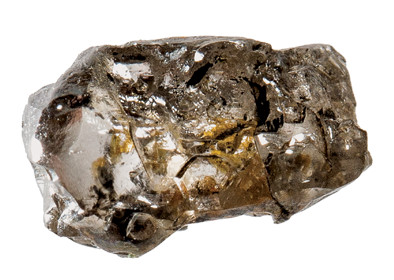
by Gabriel Popkin Thursday, July 10, 2014

This half-centimeter-wide diamond contains a speck of ringwoodite, the first known water-bearing mineral from Earth's transition zone. Credit: Graham Pearson, University of Alberta.
Studies of seismic waves traveling through Earth have long suggested that the mantle is like a layer cake, with regions of differing composition. In a layer known as the transition zone, between depths of about 410 to 660 kilometers, much of the rock is thought to be composed of pressure-squeezed variants of the common mineral olivine. One of these hypothesized forms is ringwoodite, which forms blue, cube-shaped crystals. Ringwoodite synthesized in the lab under high pressure can contain up to 2 percent water by weight, suggesting the transition zone could hold massive amounts of water. But direct evidence of this water had been nonexistent as no one had observed ringwoodite from the mantle; the only naturally occurring specimens had come from meteorites.
Now, a new study in Nature detailing ringwoodite trapped in a pebble-sized Brazilian diamond has changed that. When researchers analyzed the light scattered by the tiny crystal in the diamond — purchased from a gem dealer by a research team member who thought the diamond might hold a different mineral — they realized the inclusion was ringwoodite. “Although we didn’t find what we were looking for, we found something probably more interesting,” says Graham Pearson, a geochemist at the University of Alberta in Edmonton who led the study.
Pearson says he would have expected ringwoodite’s crystal structure to relax back to that of olivine on its way to the surface. But in this case, the rigid diamond apparently held the compressed crystal in place. This means the pressure inside the half-centimeter-wide diamond must be an astounding 20,000 times atmospheric pressure, Pearson says.
In a Nature commentary that accompanied the finding, Hans Keppler of the University of Bayreuth in Germany suggested that an unusually fast eruption may have expelled the diamond from the transition zone before the ringwoodite had a chance to convert to olivine. “Most people (including me) never expected to see such a sample,” he wrote.
Pearson and his colleagues used infrared light, which is absorbed by water, to estimate that the ringwoodite contained 1.4 percent water by weight. If the sample is typical of the entire lower transition zone, which extends from 520 to 660 kilometers deep, this layer alone would contain about as much water as the world’s oceans, Keppler wrote.
“I think they very solidly nailed the identification of this mineral,” says Joseph Smyth, a geophysicist at the University of Colorado at Boulder who suggested in 1987 that Earth’s mantle could hold large quantities of water. He calls the finding a “very dramatic confirmation” of that hypothesis. Geologists, including Smyth, have long suspected that water in the mantle lubricates Earth’s ever-shifting tectonic plates, and that the transition zone could supply water to the shallower layer on which plates ride. Pearson’s team’s sample provides the strongest support yet for this idea, Smyth says. Moreover, he says, the finding of water at such depth strongly suggests Earth — and Earth-like exoplanets — accreted water when they formed and not through later comet or meteor impacts.
But Pearson, Keppler and Smyth all caution that geologists need more such finds to determine if the sample represents the entire lower transition zone. “The magma that brought [the sample] to the surface may have come from an unusually hydrous region,” Smyth says. “It’s the only one we have, so we don’t have anything to compare it to.”
© 2008-2021. All rights reserved. Any copying, redistribution or retransmission of any of the contents of this service without the expressed written permission of the American Geosciences Institute is expressly prohibited. Click here for all copyright requests.